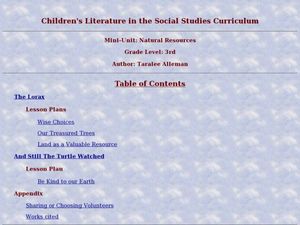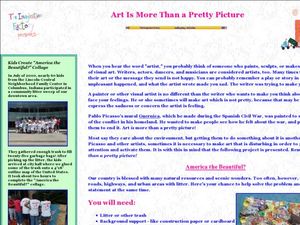Curated OER
What Role Do Forest Play in Continuing or Renewing Our Planet's Resources?
Students explore the interaction between the forest and wildlife. In this forestry lesson, students collect data about forest ecosystems, species of trees, photosynthesis, and interaction of organisms. They prepare a lab activity to...
Curated OER
NATO in Afghanistan – European and Canadian Positions
Students take a closer look at Canada's committment to NATO in Afghanistan. In this global issues lesson, students read a handout about NATO's involvement the Afghanistan conflict. Students respond to discussion questions and conduct...
Curated OER
Where Does Your Water Come From?
Young scholars engage in a lesson to determine the source of water that is used. They conduct research using a variety of resources. The lesson includes information for the teacher to share with the class. Students write and define the...
Curated OER
The Lorax
Third graders identify and list five problems presented in The Lorax by Dr. Seuss. They relate these problems to current environmental issues and debate how to make a difference then participate in different activities to improve their...
Curated OER
And Still The Turtle Watched
Third graders discuss ways to be kind to the Earth. In this conservation lesson, 3rd graders listen to the story And Still The Turtle Watched by Sheila MacGill-Callalhan. They compare how the early people treated the Earth to how we...
Curated OER
Peppered Moth Simulation Activity
Students simulate peppered moth predators using SmartNotebook. In this life science instructional activity, students collect survival data and analyze results. They explain the importance of changes in species over time.
Curated OER
Water Conservation
Students investigate water conservation. In this water conservation lesson, students list the uses for water and record their water usage for one day. Students graph the data and create a water conservation poster.
Curated OER
Shake, Rattle And Roll: Studying the Effects of an Earthquake
Learners gauge earthquake intensity by reviewing firsthand accounts. They use the Modified Mercalli Intensity Scale and newspaper articles to estimate the strength and effects of a past earthquake.
Curated OER
Floods: Rising Waters and You
Students examine the relationship between human-made structures, flood waters and the increasing population through video clips, websites and a lab experiment.
Curated OER
Art Is More Than Just a Pretty Picture
Students create unique art piece from litter. In this visual art lesson, students learn the importance of recycling and create a unique art piece. Students construct collages.
Curated OER
Fossil Fuel Scavenger Hunt
In this earth science worksheet, students complete each of the statements with the correct fossil fuel. They identify when and where electricity first became available. Students also define fossil fuels and where they first got their...
Curated OER
Worksheet #50 Questions - Amendments
In this historical quiz learning exercise, students test their knowledge on multiple historical references that relate to the Bill of Rights and the Constitution. Students answer ten fill in the blank questions.
Curated OER
The Lewis and Clark Expedition
Students study westward expansion. For this US history lesson, students describe the adventures and hardships faced by the explorers known as Meriwether Lewis and William Clark. Students write a report to the President about...
Curated OER
World History: Why Civilizations Fall
Students examine factors leading to the demise of ancient civilizations. They list causes that led to the downfall of these societies. Students conduct Internet research and participate in online archaeological investigations.
Curated OER
Liquids in Bottles
Students investigate different liquids to develop their concept of a liquid. They work at a center to tip, swirl, shake, roll, and otherwise investigate seven liquids in small, clear plastic bottles: plain water, corn syrup, liquid...
Curated OER
Natural Hazards
Young scholars evaluate the hazards of naturally occurring events. After watching a video concerning safety hazards, students work in groups to discuss the safety issues involved in taking a trip to a mountainous region. ...
Curated OER
Build-Renovate-Restore
Students discover how buildings are changed over time from their original states by nature and man. They will "create," "renovate," and "restore" a building. They then develop a time line to show the origin of his/her building and the...
Curated OER
Recycling
Students examine different "cycles" that are found in nature, such as the water cycle and recycling. They create their own artwork about cycles to be displayed on a bulletin board
Curated OER
Food Chains
Fourth graders study food chains, producers, consumers, and decomposers. They play a food chain game and create food chain mobiles or posters. They take a nature hike around the school and observe various parts of a food chain.
Curated OER
Cloud in the Classroom
Students watch a video about wild stallions and conduct research about wild horses and wildlife photography. Students explore the relationships between animals and humans and conduct Internet research about the treatment of wild horses...
Curated OER
Wetlands Currents
In this science activity, students look for the answers to questions that are related to the natural ecosystems of wetlands written in multiple choice or short answer form.
Curated OER
Water Drops
In this environment worksheet, students participate in a variety of activities. For example, students write five clues about something they might find in a natural setting.
Curated OER
Antarctic Jukebox
In this environment worksheet, students read an excerpt about Antarctica, including the many challenges explorers face. Then they imagine that they are a sound recordist in Antarctica and record 3 CDs. Students look at the images given...
Curated OER
Natural Resources and Transportation in the United States
Students study thematic maps (included with the lesson) to determine possible relationships. They develop three hypotheses about the relationship. Students choose one of their hypotheses to explain. The explanation is to include reasons...























